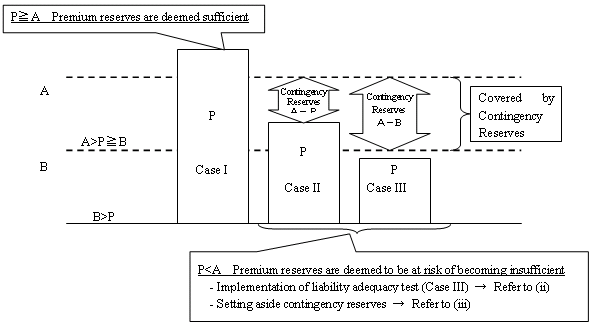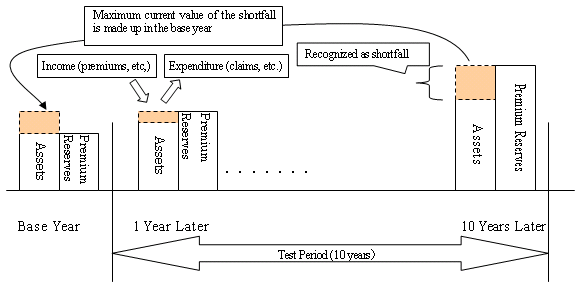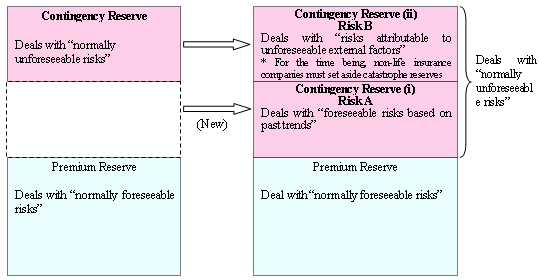| The Financial Services Agency (FSA) established new funding rules, etc. for policy reserves for third-sector insurance products, and amended the Enforcement Regulation of the Insurance Business Law, related official notifications and the Comprehensive Guideline for Supervision of Insurance Companies accordingly. |
| 1. |
Characteristics and Trends of Third-sector Products |
| |
"Third sector" refers to a sector in which claims and medical treatment benefits are paid in the event of illness or injury, as exemplified by medical insurance, cancer insurance and nursing care insurance.
There used to be entry restrictions on third-sector products in that major Japanese life insurance companies were not allowed to sell such products alone. As the restrictions have gradually been relaxed since January 2001, sales of third-sector products are rapidly increasing in line with the shift in demand among policyholders, mainly from life insurance against death to medical, nursing and other such insurances which provide security while the policyholder is alive. In fiscal 2004, annual premiums exceeded ¥3.5 trillion, accounting for more than 20% of policies of life insurance companies. |
2. |
Whereabouts of the Problem and the Solution |
| |
As Japan's population ages and the birth rate falls, policyholders' demand is growing for products such as medical insurance and nursing care insurance. However, such products are claimed to be exposed to long-term uncertainties, due to being susceptible to external factors such as public healthcare policies and unexpected behavior on the part of policyholders, in addition to many products in Japan offering lifetime coverage.
Despite these circumstances, third-sector products are rich in variety. However, there are no standard indicators such as the standard fatality rate and reference loss cost rate due to insufficient data, and in reality, there is no option but to estimate the incidence of each situation in which benefits are payable based on public data, past records of each company, etc.
Therefore, each insurance company deals with uncertainties over the incidence of an insured event under third-sector products by setting aside standard policy reserves and by carrying out ex-post-facto performance monitoring of the incidence. The reality is that the performance monitoring method and actions taken after performance monitoring are at the discretion of each insurance company. On the other hand, for contingency reserves, the problem is that the risks of each product are not properly reflected in contingency reserves because risk coefficients are defined in a uniform and mechanical manner.
Having such a critical awareness, the FSA decided to develop the following funding rules based on the results of the study conducted by the Study Team on Funding Rules for Policy Reserves and Performance Monitoring, etc. for Third-Sector Products, in order to enable insurance companies to execute risk management properly and set aside funds to fulfill its future obligations. |
3. |
Overview of Funding Rules, etc. |
|
(1) |
Implementation of Stress Test and Liability Adequacy Test |
| |
|
- |
|
The FSA decided to introduce a new performance monitoring framework to ensure that a sufficient level of policy reserves is set aside, by conducting a "stress test" and a "liability adequacy test" focusing on the uncertainties over the incidence of insured events under third-sector insurance. |
| |
|
(i) Stress Test |
| |
|
- |
|
This test aims to confirm, at the end of each fiscal year, whether or not risks are sufficiently covered by the predetermined expected incidence of an event with respect to each product. It involves forecasting the incidence at which 99% of the risks relating to the incidence during the test period (10 years) are covered based on the actual incidence of an insured event, etc. (incidence of risk A) (Figure 1), comparing the amount of claims payable in the future (Figure 2-A) with the amount of claims based on the expected incidence (Figure 2-P), and determining that the premium reserves are sufficient if the amount of claims based on the expected incidence is large (Figure 2: Case I). |
| |
|
- |
|
As the scope of coverage and risks of third-sector products is broad and varies from product to product, insurance companies are required to rationally set the model for forecasting the future incidence of an insured event. |
|
Figure 1: Forecasting the Future Incidence of an Insured Event
(Case in which expected incidence is sufficient)
|
| * Age, number of years elapsed and other such factors need to be taken into account when estimating the future incidence. |
|

|
|
Figure 2: Stress Test and Setting Aside Contingency Reserves
|
|

|
| (Note) |
P: Amount of benefits paid during test period (10 years) based on expected incidence |
| |
A: Amount of benefits paid during test period (10 years) based on incidence of risk A |
| |
B: Amount of benefits paid during test period (10 years) based on incidence of risk B |
|
| |
|
(ii) Liability Adequacy Test |
| |
|
- |
|
If there is a possibility that the predetermined expected incidence of an insured event cannot cover "normally foreseeable risks" (97.7% of risks under the new rules) which should be covered by premium reserves according to the results of the stress test, performance monitoring is conducted based on a liability adequacy test (Figure 2: Case III). |
| |
|
- |
|
As the sufficiency of premium reserves needs to be determined in terms of whether they are materially deficient in consideration of the trends in overall income and expenditure, verification is conducted based on future cash flow analysis (liability adequacy test) (Figure 3). |
| |
|
* |
|
Contingency reserves are determined by comparing the future amount of benefits (whether or not the amount of claims accruing in the future exceeds the expected amount) solely in consideration of the risks attributable to the increase in incidence to prepare against risks relating to the incidence of an insured event. |
| |
|
|
|
Figure 3: Liability Adequacy Test
|
| |
|
|
|
- In the base year, assets = premium reserves.
- Premium reserves (liabilities) are calculated at the expected base rate.
- Assets are calculated by using the income and expenditure in each year estimated from past records, etc.
* Payment of claims, etc. is set at a level at which 97.7% of risks relating to the incidence of an insured event are covered.
- Premium reserves are deemed deficient if assets fall short of premium reserves.
* The maximum current value of the shortfall needs to be made up in the base year. |
|
|

|
|
| |
|
(iii) Setting Aside Contingency Reserves |
| |
|
Contingency reserves (i) must be set aside to the level at which 99% of the risks relating to the incidence of an insured event are covered (i.e., "risk A"). (Figure 2: Cases II and III)
For the time being, contingency reserves calculated by the conventional method(Note 1) must be set aside as contingency reserves (ii) corresponding to "risks attributable to unforeseeable external factors" (i.e., "risk B"). |
| |
|
* |
|
For the time being, non-life insurance companies must set aside funds as "catastrophe reserves"(Note 2) as they always have. |
|
Figure 4: Premium Reserves and Risks of Contingency Reserves
|
|
|
|

|
| (Note 1) |
Current cap on contingency reserves of life insurance companies (example of those related to third-sector products) |
| |
- Risk of hospitalization due to illness = [Daily hospital expenses incurred due to illness] x [Average number of days for which benefits are expected to be paid] x 0.0075. |
| (Note 2) |
Current catastrophe reserves of non-life insurance companies |
| |
- 160% of net income from premiums |
|
| |
|
(iv) Solvency Margin Standard |
| |
|
- |
|
The magnitude of risk is a tenth of the amount calculated as the cap on "contingency reserve (i)" because it is set aside to prepare against risks for 10 years. |
| |
|
- |
|
The amount set aside as "contingency reserve (i)" is newly included in the solvency margin. |
| |
(2) |
Disclosure of Implementation Status, etc. |
| |
|
The incidence of an insured event under third-sector products is taken into account with respect to each situation in which benefits are payable. When making a forecast upon conducting a stress test and liability adequacy test, insurance companies are required to disclose the following information in disclosure journals as the model used is unique to each company. |
| |
|
- |
|
Approach to ensuring appropriateness of policy reserves set aside for third-sector products, and the reasonableness and appropriateness of the stress test and liability adequacy test (especially the method of setting the incidence of risks) |
| |
|
- |
|
Implementation status of stress test and liability adequacy test (status of additional premium reserves and contingency reserves) |
| |
|
- |
|
Status of payment of claims, etc. with respect to the premium in each category such as medical care, cancer and nursing care. |
| |
(3) |
Implementation of Periodic Offsite Monitoring |
| |
|
- |
|
Insurance companies will be monitored periodically with respect to contract trends by product and trends in the rate of profitability, incidence, etc. The results will be utilized as basic data to request insurance companies to take proper action. |
| |
(4) |
Enhancement of Risk Management Structure, etc. |
| |
|
(i) Ensuring Effectiveness of Option to Change
Assumed Rate |
| |
|
|
|
At present, the dominant view is that the exercise criteria are unclear for insurance policies with the option to change the
assume rate and it is difficult to exercise it in practice. Therefore, the FSA decided to introduce transparent numerical
criteria for exercising the option to change the assumed rate and oblige insurance companies to explain the reasonableness of
the expected incidence, the criteria for exercising the option to change the assumed rate (numerical criteria), nature of
changes, etc. as important matters at the time of solicitation and enhance the provision of information to policyholders such
as the outlook for changes in the premium, in an effort to ensure the effectiveness of the option to change the assumed
rate in cases where the incidence of an insured event deteriorates. |
| |
|
(ii) Enhancement of Actuary Functions |
| |
|
|
|
In addition to confirmation by actuaries based on their existing practical criteria, the FSA decided to newly implement liability adequacy tests, etc. and enhance the checking functions of actuaries with respect to the level of policy reserves set aside. The FSA also decided to oblige actuaries to submit a written statement that an actuarial check has been conducted upon filing an application for product approval. |
| |
|
(iii) Disclosure of Reinsurance |
| |
|
|
|
The FSA decided to require the disclosure of reinsurance utilization status in cases where reinsurance is utilized to manage the long-term uncertainties of third-sector insurance. |
4. |
Enforcement Date, etc. |
| |
- |
|
A statement written by an actuary that he/she has performed an actuarial check is required for applications for approval filed on or after May 1, 2006. The disclosure of reinsurance and insurance-related income/expenditure status is applicable to the fiscal year commencing April 1, 2006 and thereafter. |
| |
- |
|
The option to change the assumed rate is applicable to cases in which solicitation for insurance is done or a contract is concluded on or after April 1, 2007. Furthermore, amendments relating to premium reserves, contingency reserves and the solvency margin standard including the implementation of stress tests and liability adequacy tests are applicable to the fiscal year commencing April 1, 2007 and thereafter. |
|
|



